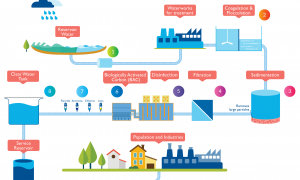🕑 Reading time: 1 minute
When we talk about the different sources of water, we usually think of surface water sources like lakes, rivers, and streams. However, approximately 97% of all of the usable freshwater is actually groundwater.
Groundwater is the water that percolates the surface of the earth and passes through the voids of rocks to meet the water table. Groundwater is formed when water percolates the surface of the earth and passes through the voids of rocks to meet the water table. These voids may either be interconnected, permitting the movement of water or be isolated, keeping the water stagnant between the interstices.
It can be said that the presence of the groundwater depends largely on the geology of a specific area and the variable porosity of the upper portion of the earth’s crust. The water below the water table or the groundwater reservoir can be extracted by natural phenomena like springs or artificially by constructing infiltration galleries, wells, springs, etc. This process of exploitation is referred to as ‘drainage of groundwater’.
Contents:
1. Infiltration Galleries
Infiltration galleries are also known as horizontal wells as they are horizontal or nearly horizontal tunnels that are constructed through the water-bearing strata along the banks of the river. The tunnel is often placed at a shallow depth of 3 to 5 meters.

The galleries are made up of masonry walls and have roof slabs. Multiple drain pipes are placed along with suitable intervals of drain to extract water from the aquifer. The drain pipes are porous and are covered with gravel to prevent fine particles from entering the pipes.
They are laid at a slope and the water is directed to a sump well. The water is then pumped, sent for treatment, and then distributed. The width of the gallery is about 1 meter and the length can be 10 meters or as long as 100 meters depending on the water field.
2. Infiltration Wells
Infiltration wells are a series of shallow wells constructed along the banks of a river. The wells collect the river water that seeps through their bottom. They have open joints and are made up of brick masonry. They are usually covered at the top and manholes are provided for carrying out inspections.

The infiltration wells are connected to a sump well, known as jack well, by multiple porous pipes. The water reaching the jack well is then lifted or pumped, treated, and distributed to the city.
A Ranney well (also known as Ranney collector) is used for extracting water from an aquifer. It is a patented type of radial well that is sunk into the ground with a direct connection to a water source.
3. Springs
Spring is the natural outflow of groundwater to the surface of the earth, indicating that the water table has outcropped. Generally, when a pervious layer is crammed between two impervious layers, it eventually gives rise to springs. In certain springs, discharge of hot water is seen due to the presence of sulphur.

A lake or pond is formed when a spring bursts from the ground. Masonry walls are constructed on all sides of the spring and then it is covered from the top to avoid contamination of water. The water is then transferred to a downstream reservoir through pipes.
There are three types of springs based on geological formations.
3.1 Gravity Springs
A gravity spring is formed when the groundwater table rises and overflows beside a natural valley or a depression.
3.2 Surface Springs
In surface springs, an impervious stratum or obstruction supporting the storage becomes inclined. As the stratum is inclined, the water level rises and the water table is exposed to the ground.
3.3. Artesian Springs
When water is flowing through a confined aquifer and the above layer is under pressure, it leads to the formation of an artesian spring.
4. Wells
A well is a vertically excavated hole on the surface of the earth that facilitates access to groundwater by bringing it up to the surface. Open wells and tube wells are the two types of wells.

4.1 Open Wells
An open well is a masonry well having a large diameter. This type of well is excavated only up to a limited depth and is suitable when the discharge is as low as 18 cubic meters per hour. The water must have a critical velocity in order to be withdrawn as higher velocities may disturb the soil grains and the well lining.
Depending on the type of strata available, open wells can be classified as shallow and deep wells.
4.2 Tube Wells
A tube well is a tube or long pipe that is bored or drilled deep into the ground. It intercepts one or more strata bearing water and generally has a small diameter.
FAQs
Infiltration galleries, infiltration wells, springs, and wells are the different types of underground water sources.
Infiltration wells are a series of shallow wells constructed along the banks of a river. The wells collect the river water that seeps through their bottom.
When a pervious layer is crammed between two impervious layers, it eventually gives rise to spring.
Read More


